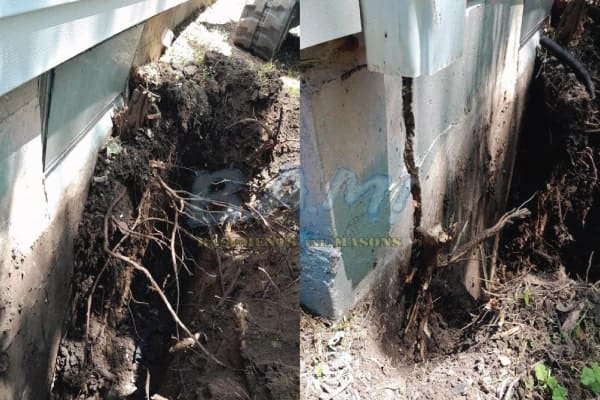EXACTLY HOW DO TREE ROOTS CAUSE FOUNDATION DAMAGE?
WATER, SOIL, AND YOUR FOUNDATION
As property owners in the Des Moines area know, the invasive roots associated with some trees can harm foundations by sucking the moisture out of the soil located beneath their homes. When this happens, it causes the soil under the foundation to contract. As a result, the house will experience foundation movement and damage. This can put foundations at great risk and even lead to cracking or bowing.
It’s important to keep in mind that trees are like people: They need water to survive. If they aren’t watered enough, their roots seek moisture wherever they can find it. In some cases, invasive roots will creep beneath foundations and deplete the soil of the moisture it needs to keep a foundation stable. A large tree that’s close to a house can add to the problem by drawing additional moisture from the soil.
WHEN TREE ROOTS INVADE YOUR FOUNDATION
You’ll notice signs like the following:
· Cracks in your foundation’s floor
· Mostly vertical cracks in your foundation’s walls
· Cracked or shattered windows
· Uneven door and window frames
· Buckling in the floor’s surface
ABOUT FOUNDATIONS CRACKS CAUSED BY ROOTS
The root systems of some trees are incredibly strong. For that reason, they can exert a whole lot of pressure on a foundation. Foundations can be pushed upward due to the sheer force of roots. While that’s not a common problem, it can and does occur. That’s why you should take precautions. It’s always best to prevent these types of concerns by being proactive.
HOW TO PROTECT YOUR FOUNDATION FROM TREE ROOTS
To avoid foundation deterioration, don’t plant new trees too close to your house. When purchasing a tree, find out how large the root system will become. If you’ve already planted a tree and suspect that it may be a problem, one possibility is to have the tree roots trimmed. Another option is to install a root barrier.
Most roots are formed near the surface of the soil and rest no more than 24” below the ground. To prevent the tree from searching for water, take time to water the roots on a regular basis. Make sure you don’t keep them exceedingly wet, just maintain a constant level of moisture. An abundance of water can harm your tree, so you don’t want to overdo it.
Consider these things when planting a tree
Trees are often unfairly blamed for foundation damage. They provide many benefits, such as natural beauty, shade, and filtering pollutants. So go ahead, plant a tree!
To protect your foundation, keep these things in mind:
Plant slow-growing trees that have less aggressive roots, such as oak or sugar maple
Avoid willow, honey locust, silver maple, or elm, unless you have a large yard
Tree roots can grow twice, even three times as wide as the tree’s height
Know the full size a tree will grow to
Plant trees far enough away from the house—at least 20 feet (but it really depends on the size and species of the tree)
Cutting down a tree is the last resort
You may have some mature trees on your property, often planted by previous homeowners. Before you consider removing a tree, you should consult a foundation repair specialist to confirm tree roots are actually present at the base of the foundation. If the backfill around a foundation hasn’t been compacted properly, tree roots may grow down when they meet the looser soil. You might be able to find these roots by digging within a few feet of your foundation. They are often found a couple of feet down. If you find any roots, cut them off.
In less common cases, you may need to excavate to the base of the foundation to remove the roots. A root barrier can be installed to prevent re-growth, although this can be expensive.
If you think you have to remove a tree, it’s not something that you should DIY. Tree removal is dangerous work and should be done by a certified professional that has the training, tools, experience, and insurance for the job.
When should you consult a foundation repair specialist?
If the foundation is already damaged call the experts at BAM Basements and Masons for your free estimate to fix or prevent further damage to your home. BAM Basements and Masons of Des Moines is your premier foundation specialist serving the Des Moines, Iowa area. If you’re located in Des Moines, Ankeny, Bondurant, Altoona, Pleasant Hill, Ames, Adel, Waukee, Indianola, Grimes, Urbandale, Johnston, West Des Moines, or the surrounding areas, we’re the place to call. We can help you avoid costly and stressful foundation repair mistakes, by giving you a customized solution that’s going to work for you and your home long-term. BAM Basements and Masons of Des Moines is a professional and locally owned and operated state-registered contractor. Offering affordable honest upfront pricing, no hidden costs, offer free estimates, and limited lifetime warranties. We use new methods and materials on all jobs. We would love to help!


